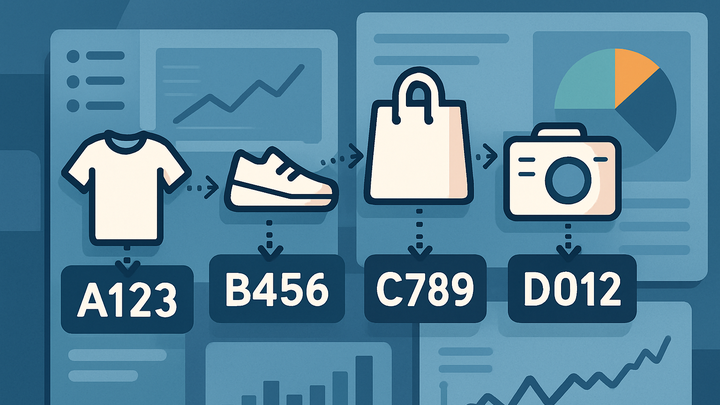Published on 2025-06-26T04:23:26Z
What is SKU Generation? Examples and Use Cases
SKU generation is the process of creating unique and consistent Stock Keeping Units (SKUs) as identifiers for products, services, or their variants in e-commerce analytics. By combining relevant product attributes—such as product ID, color, size, or other characteristics—into a standardized code, organizations can accurately track inventory, sales, and customer behavior. In analytics platforms like GA4 and PlainSignal, properly generated SKUs ensure reliable measurement of product performance, enabling granular reporting and optimization across marketing channels. Implementing SKU generation helps prevent duplication, reduces errors, and integrates seamlessly with e-commerce event tracking workflows. Whether you are using a cookie-free analytics solution or traditional tagging, SKU generation is a cornerstone of robust product analytics.
Sku generation
Process of creating unique product identifiers (SKUs) for consistent and accurate e-commerce tracking in analytics.
Definition
This section defines SKU generation and its role in e-commerce analytics.
-
What is sku generation?
Creating a standardized alphanumeric code by combining product attributes to uniquely identify each product or variant for analytics tracking.
Importance in Analytics
Why consistent SKUs matter for data accuracy and reporting across analytics platforms.
-
Accurate product reporting
Ensures that sales and inventory data map to the correct items, eliminating mix-ups between similar products or variants.
-
Cross-platform consistency
Maintains uniform identifiers across multiple tools like GA4 and PlainSignal, enabling reliable multi-channel analysis.
How SKU Generation Works
The typical process and logic for generating SKUs from product attributes.
-
Attribute concatenation
Combining multiple fields (e.g., product ID, color, size) into one string using separators or fixed positions.
-
Product id
The core numeric or alphanumeric identifier for the product line.
-
Variant information
Additional codes representing color, size, or other options.
-
-
Formatting rules
Defining element order, separator characters (e.g., hyphens), and length constraints to ensure readability and system compatibility.
Implementation Examples
Code snippets and setup for popular analytics SaaS products.
-
PlainSignal implementation
Using PlainSignal’s cookie-free tracking to send SKU codes with page views or events.
-
Tracking code snippet
Add the PlainSignal script and include your SKU generation logic in the data attributes.
<link rel="preconnect" href="//eu.plainsignal.com/" crossorigin /> <script defer data-do="yourwebsitedomain.com" data-id="0GQV1xmtzQQ" data-api="//eu.plainsignal.com" src="//cdn.plainsignal.com/plainsignal-min.js"></script>
-
-
GA4 e-commerce event
Configure GA4 to capture SKU fields in enhanced e-commerce events.
-
Gtag.js snippet
gtag('event', 'purchase', { 'transaction_id': 'T12345', 'items': [{ 'item_id': generateSKU(product), 'item_name': 'T-Shirt', 'price': 19.99, 'quantity': 2 }] });
-
Best Practices
Recommendations for scalable, reliable SKU generation.
-
Consistency
Use a fixed format and naming convention across all products and channels.
-
Uniqueness
Ensure each SKU maps to one distinct product or variant to avoid data collisions.
-
Avoid pii
Do not include personally identifiable or sensitive information in SKU codes.
Common Pitfalls
Challenges and how to avoid errors in SKU generation.
-
Duplicate codes
Inconsistent formatting or missing attributes can lead to duplicate SKUs.
-
Invalid characters
Special characters or spaces may break analytics parsing or reporting tools.
